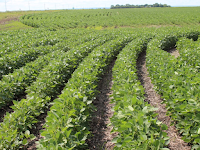Occupations of People in Madhya Pradesh
1. Farming
Madhya Pradesh, with its large area, enjoys diverse climatic and soil conditions suitable for a broad range of agricultural products. Agriculture sector in Madhya Pradesh forms the backbone of its economy. It contributes almost one-fourth of the Gross State Domestic Product (GSDP) and is the main source of employment for over 65 percent of the population and constitutes about 60- 75 percent of the rural income.
The state is a large producer of soybean and wheat. Sharbati variety of famous wheat is grown in Sehore, Vidisha and Ashok Nagar districts, and in some parts of Bhopal and Hoshangabad. Madhya Pradesh leads in the production of gram, linseed, green pea, garlic and coriander. The state is also a major producer of linseed, mustard, sunflower and safflower. Agro-climatic diversity and topographical variations enable the state to grow a wide range of cereals, pulses, oilseeds and cash crops, besides being home to myriad varieties of plant species, both in forest areas and outside. Various tropical fruits and vegetables and spices like coriander, chili and garlic are also widely grown. Areas under cultivation of safflower and sunflower are also expanding.
Protected cultivation practices are gaining momentum in Madhya Pradesh due to combined efforts of Government of India, Madhya Pradesh State Horticulture Mission and Precision Farming Development Centre (PFDC) established at ICAR-Central Institute of Agricultural Engineering, Bhopal. These farmers are not only saving water but also generating higher income as compared to earlier conventional cultivation practices.
With the adoption of hi-tech horticultural practices the farmers were able to get higher revenue over conventional crops and generated employment for four to five rural laborers in their protected structures.
2. Manufacturing Industries
Madhya Pradesh government has worked diligently over the past decade to develop the state as an industrial hub and promote it as a potential investment destination. The state government has made an investment of more than $15.4 billion in support infrastructure in the last five years. Madhya Pradesh stands 5th among Indian states in ease of doing business ranking conducted by World Bank and DIPP.6 Inland Container Depots (ICDs) have been established in the state.
The same is attributable to stable government, supplemented by creation of a robust support infrastructure in terms of roads, water supply, irrigation capacity and a 24x7 power supply.
The Government of India signed an agreement on 17th November, 1955, with Associated Electrical Industries (AEI), UK, for the establishment of a factory at Bhopal complete in all respects for the manufacture of heavy electrical equipment in India. The company was registered as Heavy Electricals (India) Limited (HE(I)L) in the Public Sector under the Ministry of Industry and Commerce on 29th August, 1956.Today this company is known as BHEL. This was a historic moment which gave rise to numerous industries in Madhya Pradesh.3. Livestock Rearing and Fisheries
Madhya Pradesh has about 0.1 million crossbred cattle, 3.4 million non-descript cattle and 2.8 million buffaloes in milk, producing around 6.3 million tons of milk annually, and buffaloes are contributing the major share (3.4 million tons). Besides, 12 million poultry are contributing 1 billion eggs per annum.Madhya Pradesh has 17,088 km of rivers and canals, 4.6 lakh ha of reservoirs and 60,000 ha of ponds and tanks that produce about 51,000 tons of fish. The average fish yield from FFDA ponds is about 1.5 tons/ha/year. On account of the vast resources, even a marginal increase in yield rate in the reservoirs of the state can contribute a substantial quantity of fish to the production basket.
In the year 1980, Madhya Pradesh Milk Federation Sahakari Maryadit (currently MP State Cooperative Dairy Federation Ltd.) was established under Madhya Pradesh Cooperative Societies Act 1960 to conduct coordinated dairy development activities in the cooperative sector in the state through Operation Flood program. was established. With this, the formation of three-tier cooperative institutions on the Anand system started. Under this, there are about 7000 rural milk cooperative societies at the first level, 6 cooperative milk unions at the second level, while MP State Co-operative Dairy Federation (MPCDF) is functioning at the state level.
4. Tourism
Tourism in Madhya Pradesh has been an attraction of India because of its location in the center of the country. Madhya Pradesh has won Best Tourism State National award for 3 consecutive years i.e. 2017, 2016 and 2015.One half of the state is forested and offers a unique panorama of wildlife.
The natural environment of Madhya Pradesh is varied. Consisting largely of a plateau streaked with the mountain ranges of the Vindhyas and the Satpuras, the hills give rise to the main river system - Narmada and the Tapti, running from east to west, and the Chambal, Sone, Betwa, Mahanadi west to east.Although the modern state of Madhya Pradesh came into being in 1956, its cultural heritage is ancient. Innumerable monuments, exquisitely carved temples, stupas, forts and palaces on hilltops, raise in the visitors mind visions of empires and kingdoms, of the great warriors and builders, poets and musicians, saints and philosophers; of Hinduism, Buddhism, and Jainism.5. Mining Industry
Pre-bifurcation Madhya Pradesh contained vast mineral deposits and the scope of mining was immense. However when the state was divided in 2002, deposits of minerals like Iron ore, Tin ore, Corundum, Coal, Limestone, Dolomite and Bauxite passed over to Chhattisgarh. So it became imperative to introduce a new mining policy to mark formerly unidentified mineral deposits and ensure mining takes place scientifically to maintain environmental balance.
General mining surveys are conducted by the Geological Survey of India while elaborate surveys are undertaken by the State Directorate of Geology and Mining. The survey of minerals valuable in the market and having export potential are conducted on priority basis.













Comments
Post a Comment